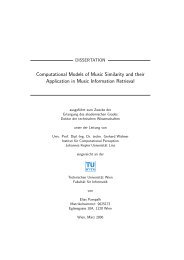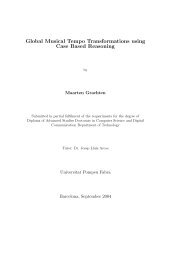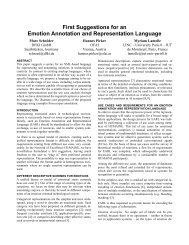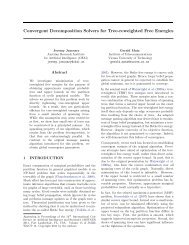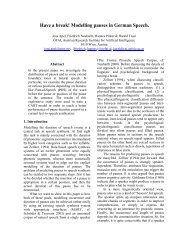A HYBRID MODEL OF REASONING BY ANALOGY
A HYBRID MODEL OF REASONING BY ANALOGY
A HYBRID MODEL OF REASONING BY ANALOGY
You also want an ePaper? Increase the reach of your titles
YUMPU automatically turns print PDFs into web optimized ePapers that Google loves.
Another architecture which, though not hybrid, is related to ours is NETL (Fahlman, 1979). In<br />
NETL, like in our cognitive architecture, many symbolic processors run in parallel performing a<br />
marker passing task. However, there is a number of important differences. First, in NETL all<br />
symbolic processors are the same computing machines, whereas in our architecture they are<br />
specialized ones, i.e. besides some general abilities for marker passing each processor has some<br />
hard-wired knowledge about a specific task (how to perform a specific action of the reasoner).<br />
Second, markers in NETL are, actually, marker bits (tokens) each with a specific meaning,<br />
whereas markers in the present architecture are essentially pointers to other nodes.<br />
7.2. Models of Analogy<br />
General Approach.<br />
Syntactic vs. Pragmatic Approach.<br />
As regards the well known discussion about the priority of syntactic and pragmatic constraints on<br />
analogy (Gentner, 1983, 1989, Holyoak and Thagard 1989a, 1989b), I recognize the importance<br />
of both constraints and involve both of them in AMBR. In some sense, however, I can be regarded<br />
as a stronger supporter of the pragmatic approach than Holyoak as I back up the dominance of<br />
pragmatics on all other processes and claim that even the computation of semantic similarity is<br />
influenced by pragmatic factors. On the other hand, I have proposed a weaker pragmatic constraint<br />
offering a broader understanding of pragmatics as relevance to the whole context - associative<br />
relevance - not just to the problem goal.<br />
Parallel vs. Sequential Processing.<br />
Traditional models of analogy assume that retrieval, mapping, transfer, evaluation and learning are<br />
sequential steps of the reasoning process and even try to model them separately (Hall, 1989,<br />
Gentner, 1983, 1989, Holyoak and Thagard, 1989a, 1989b, Thagard et al., 1990, Wolstencroft,<br />
1989). On the contrary, I consider them as parallel running processes which mutually influence<br />
their behaviors and therefore they cannot be modeled separately. Eskridge (this volume) also<br />
advocates the mutual interaction of these processes and proposes his Continuous Analogical<br />
Reasoning theory.<br />
Dynamic Aspects and Context-dependence of Human Reasoning.<br />
Most models of analogy restrict the context to the target problem's description. Eskridge (this<br />
volume) extends it with the type of reasoner's task: problem solving, learning, etc. This, however,<br />
cannot account for the dynamic aspects of human reasoning.<br />
Hofstadter (1985) and Mitchell & Hofstadter (1990) deal with these dynamic aspects by allowing<br />
two concepts to be considered as similar in one situation and dissimilar in another. This is,<br />
however, due to random factors in their model rather than to differences in the contexts (they<br />
consider only the problem description).<br />
In the following subsections I will review the models proposed for retrieval and mapping in more<br />
detail.<br />
7.2.1. Retrieval.




